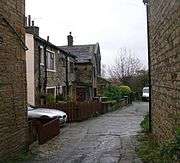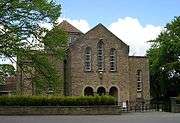Eccleshill, West Yorkshire
| Eccleshill | |
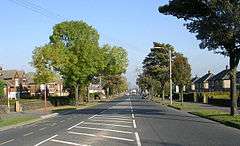 Harrogate Road, Eccleshill |
|
 Eccleshill |
|
| Population | 17,945 (Ward. 2011) |
|---|---|
| OS grid reference | SE175358 |
| Metropolitan borough | City of Bradford |
| Metropolitan county | West Yorkshire |
| Region | Yorkshire and the Humber |
| Country | England |
| Sovereign state | United Kingdom |
| Post town | BRADFORD |
| Postcode district | BD2 & BD10 |
| Dialling code | 01274 |
| Police | West Yorkshire |
| Fire | West Yorkshire |
| Ambulance | Yorkshire |
| EU Parliament | Yorkshire and the Humber |
| Councillors | Ann Wallace (Liberal Democrats) |
| Geoffrey Reid (Liberal Democrats) | |
| Ruth Billheimer (Labour) | |
Coordinates: 53°49′26″N 1°44′13″W / 53.824°N 1.737°W
Eccleshill is an area, former village, and ward in the City of Bradford Metropolitan District in the county of West Yorkshire, England. The ward population of Eccleshill is 17,540,[1] increasing at the 2011 Census to 17,945.[2]
Eccleshill is a more or less completely residential urban area with very little open space[1] although there is substantial open land directly to the east.
The origins of the name Eccleshill are uncertain. At the time of the Domesday Book the area was known as Egleshill either meaning 'eagles hill'[3] or perhaps named after a Saxon landlord called Aikel or Eckil—alternatively it could mean Ecclesiastical Hill.[4]
History
In Roman times the Eccleshill area was crossed by two lanes. One lane was along what is now Norman Lane and the other to Apperley Bridge down the road now known as Bank.[4]
After the Norman Conquest the lands of Eccleshill were given to William, Earl of Warren.[3] In 1274 ownership of lands passed to the Sheffields and in 1407 to the Bolling family of Calverley then the Scargills, Saviles, Wyatts, Zouches, Stanhopes, Hirds, and then to Jeremiah Rawson.[3]
In the Middle Ages Eccleshill was shunned by church authorities after a supposed incident in which it is said a preacher or monk was stoned to death on the main road though Eccleshill village.[4] This supposed incident is said to be the reason behind naming the main road 'Stony Lane'. The real explanation may be that either the road was stony or that it led on to Stone Hall.
Eccleshill Hall

In 1713 Eccleshill Hall was built for Dr Stanhope, located to the east of Stony Lane at the site of previous Eccleshill Halls, on what is now Victoria Road.[3] Eccleshill hall was demolished in 1878 and all that remains are parts of stone gateposts embedded in a roadside wall.[4]
Church history
Initially the churches built in Eccleshill were nonconformist. Before 1775 the only place of worship in Eccleshill was The Quaker Meeting House on Tunwell Lane.[5] In 1775 Prospect Chapel also known as Bank Top Chapel a Wesleyan Chapel was constructed on Lands Lane off Norman Lane.[6] In 1776 Methodist John Wesley (1703-1791) preached there.[6] On the opposite side of Norman Lane is Prospect Chapel burial ground, created in 1823.[4] Doctrinal disagreement led to a split and the establishment in 1823 of Salem Independent Chapel.[5] Salem Chapel and Sunday school both now demolished, were built on Dobby Row, an event that was to prompt the renaming of the street to Chapel Street.[4] The Chapel Street chapel was eventually replaced by the Congregational Church on Victoria Road near Harrogate Road, built in 1889.[5] Salem Chapel burial ground remains on Chapel Street.[4] The Congregational Church was demolished in the 1960s and the United Reformed Church, a single storey building built on the site in 1967 and the Congregational Church building was demolished in 1979/80.[5]
A further split at Prospect Chapel had led to the establishment of Eccleshill United Methodist Chapel on the corner of Workhouse fold now named Stewart Close.[5] In 1854 the remaining worshippers of Prospect Chapel built Eccleshill Wesleyan Methodist Chapel in Stony Lane and sold Prospect Chapel.[5] The old Prospect Chapel building had many subsequent uses including as an organ works.[3] When congregations shrank at the Wesleyan Methodist Church on Stony Lane worshippers moved to join the Primitive Methodist Chapel built in 1911 on Norman Lane to become Eccleshill Methodist Church.[5] There are plans to demolish the Eccleshill Methodist Church and replace it with apartments. The Wesleyan Methodist Chapel was sold in 1965 then became the Ukrainian Autocephalic Orthodox Church.[5][7]
|
Construction of St. Lukes church was ordered by the Rev William Scoresby, Vicar of Bradford[3] and this was consecrated in 1848. It was designed in a vertical Gothic style with a spire, however the spire was removed in circa 1971 when the stonework began crumbling.[4] The ecclesiastical parish of Eccleshill takes in Greengates, and Apperley Bridge south of the River Aire.
Industrial, commercial and transport history
The quarrying, pottery, spinning and weaving industries have been located in the area for some time but only quarrying remains today.
Wool and Mills
Eccleshill has a number of mills. The Old Mill on Victoria Road was a woollen mill built in 1800 but was destroyed by fire in 1816.[8] The present building on the site is dated 1863 although parts of it date back to the early 1800s. On the other side of Victoria Road from the Old Mill is a row of houses and street once known as Dobby Row - a dobby being part of an early form of weaving loom - a Dobby loom, itself taking its name from a corruption of the words 'draw boy' - a weaving assistant.[4]
In around 1816 Union Mill on Harrogate Road was constructed for the manufacture of woollens.[4] Later a further three storey mill building was added to the south of the site. From 1892 to 1983 John Pilley and Sons owned and operated the mills[9] and so the mills became known as Pilley's Mill. Union Mills had a serious fire in 1905.[10] Today the buildings are a mixture of commercial and light industrial units but there are plans to redevelop the whole site.
In the 1838 White's Directory Eccleshill is described as engaged in the manufacture of white woollen cloth.[3] In 1872 Tunwell Mill was built by Messrs Smith and Hutton as a woollen mill[3] on Tunwell Lane near Tun Well (Town Well) directly south of Stony Lane—although today's Tunwell Mills are not the original mill building.
At the north end of Stone Hall Road is a mill variously known as Stone Hall Shed and Whiteley's Mill where worsted was manufactured.[11] Halfway down Stone Hall Road off to the west stood Victoria Mill, a worsted mill. This mill has been demolished and domestic properties now stand on the site.[4]
Moorside Mills was built on Moorside Road in 1875 by John Moore for worsted spinning.[12][13][14] In 1919 two floors were added and a clock tower as a war memorial to those who had died in the First World War.[10] Ownership of the mill changed hands many times and in 1970 Bradford Metropolitan District Council bought the property from Messrs. W. & J. Whitehead to create the Bradford Industrial Museum.[13]
|
Pottery
In 1837, the Manor Pottery was established by Jeremiah Rawson, lord of the manor on a site east of the Undercliffe Road-Pullan Avenue junction using beds of shale, fireclay and coal at a deep quarry near Bolton Junction[3][8][15] at a site now partly occupied by Kents Fitness Gym. There was a rail tunnel under Leeds Road, then known as Pottery Lane, with waggons carrying clay from the quarry to the pottery on the other side of the road.[3] Manor Pottery produced a salt glazed brown stoneware, household utensils, brown and cream crockery, ornaments, garden vases, busts, and statuettes although these did not bear any distinguishing marks.[4][8][15][16] Although the product stood comparison with other local wares, the local market for pottery was eventually supplied by better and cheaper stoneware from Staffordshire, and by 1867 the pottery had been sold to William Woodhead and production switched over to house bricks, firebricks and sewer pipes.[3][15][16] The kilns were shut down in the early 20th century, and in 1921 the chimney was demolished,[3][15] however the manor house still remains.[3][17]
Coal Pits
There were numerous coal pits in what is now the Thorpe Edge and Ravenscliffe areas of Eccleshill. This coal was required for steam powered machinery and the pottery. Unfortunately the digging of the coal pits caused many local water wells to run dry.
Eccleshill Mechanics' Institute

Eccleshill Mechanics' Institute on Stone Hall Road was built in 1868.[18] Charles Bottomley converted the upper floor of the Eccleshill Mechanics' Institute into a 359 seat picture hall which he named Eccleshill Picture House and then opened in 1911.[19] Shortly after this the cinema was renamed 'Picture Palace' but closed in 1931 never running any 'talkies'.[3][19] Before construction of the building the institute used to meet in the now demolished school buildings at the western end of Chapel Street on a site now occupied by Eccleshill Victoria Conservative Club.
Shopping
For the last two hundred years the shopping centre for Eccleshill has been Stony Lane and it was here that Henry Sparks, founder of Sparks Bakeries, had his first shop.[3]
Transport history
In 1804 the Dudley Hill to Killinghall turnpike was constructed.[3] In 1889 Mill Lane, Town Lane and Town Street were renamed Victoria Road to mark the Golden Jubilee of Queen Victoria that year.[4] The tram service came from central Bradford up Stone Hall Road to a terminus in front of the Eccleshill Mechanics Institute.[3] The tram service also went along Harrogate road but because of the low rail bridge at Eccleshill Station only single decker trams could get under.[20]
The Railway and Eccleshill Railway Station
In 1874 the Great Northern Railway opened its Laisterdyke - Shipley branch (the Shipley and Windhill line), a six-mile double track branch line from Quarry Gap junction in Thornbury to Shipley and Windhill railway station, passing Eccleshill, Idle and Thackley railway stations.[21] Eccleshill railway station opened in 1875 with its sidings and coal yard.[18] This was located just north of the rail bridge crossing over Harrogate Road. Only the embankment and abutment of one side of the rail bridge remain.[4] The former Station Hotel on Harrogate Road took its name from its proximity to the railway station. The railway station closed to passengers in 1931 although goods traffic continued on the line until 1964.[22] Subsequently the line was taken up and the bridge demolished.
The Palladium / Regal cinema
In 1928 Ralph Dickinson created the purpose-built 1,000 seat Palladium Cinema on Norman Lane, opened in 1929.[19] Later the cinema changed ownership and in 1931 the new owner John Lambert altered the name to Regal.[19] In 1958 the cinema closed for refurbishment and updating, and reopened later that year, but closed finally in 1966.[19] Later with the construction of an extra internal floor the building was used as a bingo hall, a snooker hall and then a fitness centre.[19]
Schools history
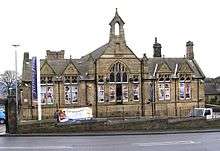
The school on Fagley Lane was built in 1845.[4] The school in Chapel Street (1875) was declared unsuitable in 1884 and to replace it the Central Board School was built in 1887 on the site of the old Eccleshill Hall.[3] In 1889 the Central Board School was renamed Hutton School after the chairman of the School Board.[3] After a period as a fitness centre the building was demolished in 2016 to make way for housing.
Geography
Eccleshill is bounded in the east by Pudsey and Fagley Beck— flowing a short distance directly north under the name Carr Beck to meet the River Aire. To the south is Bradford Moor, round to the west Undercliffe and Bolton, to the north Idle, and to the north-east Greengates.
 |
Idle Moor, Wrose |
Idle | Greengates, Calverley |  |
| Swain House | |
Pudsey | ||
| ||||
| | ||||
| Bolton | Undercliffe, Bolton and Undercliffe ward |
Bradford Moor |
Fagley
Fagley is an area to the south-east of Eccleshill ward. The local economy includes a sandstone quarry,[23] and a riding school.[24] Most of the shops including the post office are on Fagley Road running east-west.[25] To the east in Lower Fagley is Fagley's only existing pub, the Blue Pig Inn in rural surroundings next to Fagley Beck, the Leeds Country Way bridle path, and the border with Pudsey.[26][27] The local school is Fagley Primary School[28] and in the east of Fagley is the Fagley Youth and Community Centre.[29]
Ravenscliffe
Ravenscliffe is a housing estate in the north-east of Eccleshill. In Ravenscliffe is a sub post office[30] and The Gateway Community and Children's Centre.[31]
Landmarks

At the junction of Stony Lane and Victoria Road by the roadside was the 19th century lock-up and a public urinal, however these have been walled up for some considerable time. The lock-up and urinal are now over-topped by a section of raised stone paved pavement with railings known as 'The Monkey Bridge'[3] overlooking a small triangular area of land at the road junction that was the site of the village stocks.
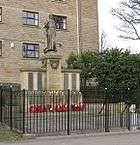
North of Stony Lane is the former Stoney Lane Quarry now a recreation ground known as The Deph, a grassed area with a fenced children's play ground and triangulation pillar.[32] South of Stony Lane is a grassed recreation ground or common with Village Green Status. Cricket and football were played here but more suitable grounds became available.[3] Eccleshill War Memorial is on the northern side[33] and to the south of the Recreation Ground on Moorwell Place is a terrace of listed former weavers' houses[34] and a bowling green.
There are many historic wells in Eccleshill, e.g. Moor Well, and Tun Well however there is a Holy Well covered by a manhole cover, located in a private garden off Harrogate Road opposite the end of Ravenscliffe Avenue, close to the site of Eccleshill Railway Station. This historic well and its associated grove dates back to Roman times.[35]
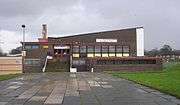
The Eccleshill (Swimming) Pool is located on Harrogate Road towards Greengates.[36]
To the east of Harrogate Road can be found the Eccleshill NHS Treatment Centre,[37] and playing fields. East of the playing fields is the Eccleshill Community Hospital,[38] Eccleshill Park—an area of grassland, and the Eccleshill Adventure Playground.[39]
Eccleshill has four post offices, one on Harrogate Road, one in Fagley and anothers in Ravenscliffe and Thorpe Edge. There is also a driving test centre on Victoria Road.[40] Eccleshill Police Station is not in Eccleshill ward but just outside in Idle.[41] At the western end of Norman Lane is Enterprise 5, a large shopping centre with a Morrisons supermarket together with Poundland, Poundstretcher, Pets at Home and Pure Gym and other shops.[42]
Eccleshill has a number of public houses particularly along Victoria Road and Norman Lane, however several public houses along Harrogate Road have closed in recent years.[43]
- Listed buildings
Eccleshill's listed buildings include private houses on Moorside Road,[44] the Ukrainian Autocephalic Orthodox church, a public house and a private house on Stony Lane,[45] private houses on Stone Hall Road and Back Stone Hall Road,[46] listed farmhouses and former farmhouses on Fagley Lane and Fagley Road,[47] listed three-storey former weavers' houses (1851–54) on Moorwell Place,[34] and a listed former Wesleyan chapel (1775) on Lands Lane.[48] and the Manor House off Leeds Road.[17]
|
Bradford Industrial Museum
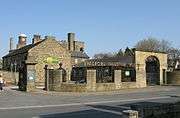
In the south of Eccleshill off Moorside Road close to Fagley is the Bradford Industrial Museum in what was Moorside Mills.[13][49] This museum houses machinery from local textile and printing industries and has a row of workers houses. It used to house the popular Horses at Work exhibition but this has now closed.[50]
Churches
Originally built in 1854 as a Wesleyan Methodist Church, the Ukrainian Autocephalic Orthodox church is the only listed church building in Eccleshill.[7] Tucked behind this church is a former Wesleyan Sunday School of 1885,[4] now residential accommodation.
|
Governance
Eccleshill was an independent township up until 1899 when along with Thornton, Tong, Idle and North Bierley it joined with Bradford.[3][18] As of 2004, Eccleshill ward includes the south-east quadrant of Greengates, Thorpe Edge housing estate, part of Five Lane Ends, Bank Top, the eponymous Eccleshill, Fagley and the Ravenscliffe housing estate.[1]
Economy
To the east of Eccleshill near Fagley is a sandstone quarry.[23] Along the south-western end of Victoria Road is the Victoria Industrial Estate including The Old Mill and a variety of commercial and light industrial units.[51] Similarly, nearby Union Mills (Pilley's Mill) is a mixture of commercial and light industrial units.
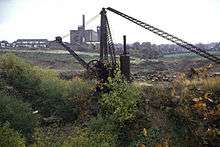
Education
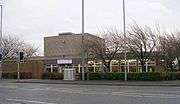
To the west in Swain House is the Hanson Academy and off Harrogate Road is Eccleshill North Middle School,[52] while Eccleshill Public Library is on Bolton Road.[53] Also home to Fagley primary school, Falsgrave Avenue, Fagley
Transport
The area is served by the First Bradford 640, 641 and 645 Green Line bus services. The main roads through the area are the north—south A658 Harrogate Road, and the A6176 Bolton Road—Pullan Avenue.
Sport
Eccleshill United Football Club are currently members of the Northern Counties East Football League Premier Division. Other local sports teams include Eccleshill Badminton Club[54] who use the facilities of Hanson Academy, and Victoria Rangers A.R.L.F.C. and Victoria Rangers A.F.C. who use the facilities of Eccleshill Sports and Social Club.[55] On the Union Mills site next to Pilley's Mill is a reservoir or mill pond known as Pilley's Dam. This reservoir is used for recreational angling and angling competitions and bream, carp, perch and pike can be caught.[56]
Events
The Eccleshill Village Fair is held annually in The Delph a grassed over former Stoney Lane Quarry north of Stony Lane.[57] The spelling of Stoney/Stony Lane is contentious even today although older maps favour the Stoney spelling.
Notable people
See the category People from Eccleshill.
Artist David Hockney (b. 1937) grew up in Eccleshill.[58] TV presenter, journalist, and game show host Richard Whiteley (1943–2005) was born in Eccleshill into a family of mill owners, and lived there in his youth.[11] The company was Thomas Whiteley & Co. (1889–1963) worsted manufacturers[11] based in mill premises off Stone Hall Road. TV presenter and journalist Christa Ackroyd (b. 1957) and actor Duncan Preston (b. 1946) were born in Eccleshill.[59]
Popular Victorian actress and 'postcard beauty' Marie Studholme (1872–1930) was born at Stone Hall, Eccleshill.[60] Inventor Edward Spurr (1907–1998) was brought up in Eccleshill[61] and Yorkshire and England cricketer Don Brennan (1920–1985) was born in Eccleshill.[62]
Arthur Wood (1898–1973), a Yorkshire and England cricketer was born in Fagley[63] and Eric Anderson (1915–1943), a posthumous recipient of the Victoria Cross lived in Ashfield Place, Fagley.[64]
References
- 1 2 3 "Bradford General Ward Profile". westyorkshireobservatory.org. 2011. Retrieved 22 February 2013.
- ↑ "City of Bradford Ward population 2011". Neighbourhood Statistics. Office for National Statistics. Retrieved 19 February 2016.
- 1 2 3 4 5 6 7 8 9 10 11 12 13 14 15 16 17 18 19 20 21 22 Eccleshill Local History Group (January 1990). Memories of Eccleshill. Department of External Studies, University of Leeds.
- 1 2 3 4 5 6 7 8 9 10 11 12 13 14 15 16 "Eccleshill History Trail" (PDF). Bradford Metropolitan District Council. Retrieved 27 July 2010.
- 1 2 3 4 5 6 7 8 Kenzie, Kenneth (February 2012). Eccleshill Echoes 1. Self published.
- 1 2 "Eccleshill Methodist Church". Bradford North Circuit. 14 December 2009. Retrieved 12 December 2009.
- 1 2 "Ukrainian Autocephalic Orthodox Church". British Listed Buildings. Retrieved 14 February 2013.
- 1 2 3 Hartley, John (June 2002). "St Luke's Church Eccleshill". Retrieved 24 February 2013.
- ↑ "John Pilley and Sons, Union Mills, Eccleshill, Bradford". The National Archives. Retrieved 2 March 2013.
- 1 2 "History of Bradford, Yorkshire - 1900 to 1949". Bradford Timeline. Retrieved 12 December 2009.
- 1 2 3 Mangan, Lucy (26 June 2005). "Farewell to a jolly good egg". The Guardian. Retrieved 12 December 2009.
- ↑ "Bradford Industrial Museum". BBC Home. Retrieved 12 December 2009.
- 1 2 3 "Bradford Industrial Museum". Visit Bradford. Retrieved 12 December 2009.
- ↑ "Bradford Industrial Museum & Horses at Work". Culture24. Retrieved 12 December 2009.
- 1 2 3 4 Barker, Derek. "Old Bricks - History at your feet". Penmorfa. Retrieved 24 February 2013.
- 1 2 Graham, Oxley (1916). "Yorkshire potteries, pots and potters". Internet Archive. Retrieved 24 February 2013.
- 1 2 "Manor House". British Listed Buildings. Retrieved 1 March 2013.
- 1 2 3 "History of Bradford, Yorkshire - 1850 to 1899". Bradford Timeline. Retrieved 12 December 2009.
- 1 2 3 4 5 6 Sutton, Colin (2004). "Bradford - Eccleshill Cinemas History". A History of Bradford Cinemas. Retrieved 21 December 2014.
- ↑ Kenzie, Kenneth. Eccleshill Echoes 3.
- ↑ Bairstow, Martin (1999). The Great Northern Railway in the East Riding. Martin Bairstow. ISBN 1-871944-19-8.
- ↑ Joy, David (1984). A Regional History of the Railways of Great Britain Volume VIII South and West Yorkshire. David St John Thomas. ISBN 0-946537-11-9.
- 1 2 "Hard York Quarries Ltd". Yell. Retrieved 20 February 2013.
- ↑ "Throstle Nest Riding School". BradfordOnline. Retrieved 20 February 2013.
- ↑ "Killinghall Road P.O". Yell. Retrieved 19 February 2013.
- ↑ "The Blue Pig Inn". BradfordOnline. Retrieved 19 February 2013.
- ↑ "Fagley (Bradford, West Yorkshire)". h2g2. 17 May 2003. Retrieved 20 February 2013.
- ↑ "Fagley Primary School". Bradford Schools Online. 2012. Retrieved 19 February 2013.
- ↑ "Fagley Youth and Community Centre". Newlands Community Association. Retrieved 19 February 2013.
- ↑ "Ravenscliffe Post Office Opening Times". Post Office Ravenscliffe. Archived from the original on 18 January 2013. Retrieved 14 January 2013.
- ↑ "The Gateway Community Centre". thegateway.co.uk. Retrieved 11 January 2013.
- ↑ "Triangulation Pillar S4196: Eccleshill". Bench Mark Database. Retrieved 3 January 2015.
- ↑ "Eccleshill War Memorial". Bradford Parks & Landscape Service. Retrieved 19 February 2013.
- 1 2 "1-23 Moorwell Place". British Listed Buildings. Retrieved 14 February 2013.
- ↑ Bennett, Paul (12 September 2008). "Holy Well, Eccleshill". The Northern Antiquarian. Retrieved 13 March 2010.
- ↑ "Eccleshill Pool". Bradford Metropolitan District Council. 2009. Archived from the original on 20 November 2009. Retrieved 12 December 2009.
- ↑ "Eccleshill NHS Treatment Centre". NHS Healthcare Bradford. Retrieved 11 January 2013.
- ↑ "Eccleshill Community Hospital". NHS Choices. Retrieved 11 January 2013.
- ↑ "Eccleshill Adventure Playground". Bradford Community Environment Project. Retrieved 23 January 2013.
- ↑ "Bradford (Eccleshill) Driving Test Centre". Directgov. Retrieved 12 December 2009.; "Bradford (Eccleshill) Practical Test Centre". Retrieved 12 December 2009.
- ↑ "Welcome to the Eccleshill Neighbourhood page". West Yorkshire Police. 10 December 2009. Retrieved 12 December 2009.
- ↑ "Enterprise 5, Bradford". Completely Retail. Retrieved 26 March 2016.
- ↑ "Pubs in Eccleshill". Pubs Galore. Retrieved 14 February 2013.
- ↑ Moorside Road: "2 and 4"., "3"., "6, 8, 10"., "31"., "155"., "223, 225 and 227"., "229 and 231"., "Haigh Fold"., and "1 to 15 Ashfield Place". British Listed Buildings. Retrieved 14 February 2013.
- ↑ Stony Lane: "Ukrainian Autocephalic Orthodox Church"., "Royal Oak Public House"., "9". British Listed Buildings. Retrieved 14 February 2013.
- ↑ Stone Hall Road:"Mechanics Institute".; "73, 75 and 77"., "78 and 80"., "82"., "Old Stone Hall"., Back Stone Hall Road: "28 and 30". British Listed Buildings. Retrieved 14 February 2013.
- ↑ Fagley Lane: "Throstle Nest Farmhouse"., "Cherry Tree Farmhouse"., Fagley Road: "former Ravenscliff Farmhouse". British Listed Buildings. Retrieved 14 February 2013.
- ↑ "3a Lands Lane". British Listed Buildings. Retrieved 14 February 2013.
- ↑ "Bradford Industrial Museum & Horses At Work". Britain's Finest. Retrieved 12 December 2009.
- ↑ Winrow, Jo (16 August 2011). "Consultation on Bradford heavy horses 'was a sham'". Bradford Telegraph and Argus. Retrieved 24 February 2013.
- ↑ "Victoria Road, Bradford". BradfordOnline. Retrieved 16 February 2013.
- ↑ "Eccleshill North Middle School, Greengates". schooletc.co.uk. Retrieved 11 January 2013.
- ↑ "Eccleshill Library". City of Bradford Metropolitan District Council. 2009. Archived from the original on 18 November 2009. Retrieved 12 December 2009.
- ↑ "Eccleshill Badminton Club". eccleshillbadminton.co.uk. Retrieved 11 May 2013.
- ↑ "Victoria Rangers ARLFC". Pitchero. Retrieved 11 January 2013.
- ↑ "Angling lines". Bradford Telegraph and Argus. 3 November 2011. Retrieved 2 April 2015.; "Pilleys Dam, Eccleshill". Fishingwarehouse Forum. Retrieved 2 April 2015.
- ↑ "The Greatest Eccleshill Village Fair Yet!". the eccymeccy. 27 August 2014. Retrieved 3 January 2015.
- ↑ Greenhalf, Jim (9 July 2012). "David Hockney at 75". Bradford Telegraph and Argus. Retrieved 25 February 2013.
- ↑ "West Yorkshire Thespians". Bingley Little Theatre. Retrieved 14 March 2011.
- ↑ Bailey, Peter (2004). "Studholme, Marie (1872–1930)". Oxford Dictionary of National Biography. Oxford University Press. Retrieved 27 June 2008.
- ↑ "Bradford's forgotten inventor Edward Spurr". Bradford Telegraph and Argus. 16 June 2011. Retrieved 24 February 2013.
- ↑ "Don Brennan". ESPN cricinfo. Retrieved 24 February 2013.
- ↑ Warner, David (2011). The Yorkshire County Cricket Club: 2011 Yearbook (113th ed.). Ilkley, Yorkshire: Great Northern Books. p. 382. ISBN 978-1-905080-85-4.
- ↑ "Sfax War Cemetery Tunisia". WW1Cemeteries.com. Retrieved 23 February 2013.
External links
- The Eccleshill History Trail, PDF
- Cinemas of Eccleshill
- The Eccy Meccy
- Eccleshill at DMOZ
- Sport: Eccleshill Badminton Club, Eccleshill Road Runners.
- Eccleshill ward
- BCSP (Internet Explorer only)
- Ward Labour Profile Eccleshill
- BBC election results
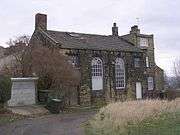
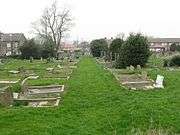
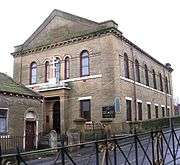
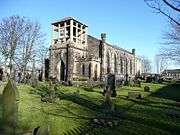
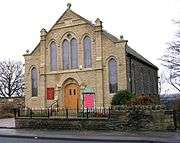


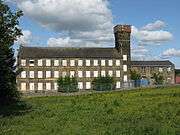
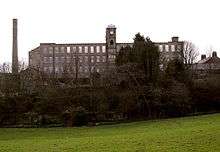

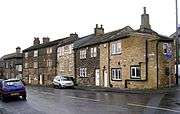
.jpg)
